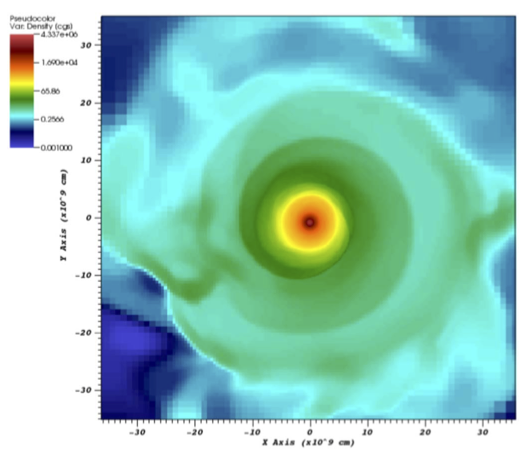Octo-Tiger an astrophysics program simulating the evolution of star systems
Applications
Simulating 3D Merger Events to 1D Stellar Evolution
R Coronae Borealis (RCB) stars are rare hydrogen-deficient carbon-rich variable supergiants thought to be the result of dynamically unstable white dwarf (WD) mergers. To model RCB stars through all the relevant timescales, a merger simulation of mass ratio 0.6 carried out by Octo-Tiger was mapped into MESA (Modules for Experiments in Stellar Astrophysics), a 1D stellar evolution code. Octo-Tiger was initialized with a 0.5 solar mass carbon-oxygen (CO) WD and a 0.3 solar mass helium (He) WD in a binary with an orbital period of 150 seconds. A combined equation of state, which takes into account pressure from degenerate electrons at zero temperature together with thermal pressure of an ideal gas, was used. Seven levels of refinement based on density criterion in a grid containing initially 24,000 subgrids were simulated. The dynamically unstable merger event initiated after about an hour. Due to the mass transfer a hot shell with a peak temperature of about 285 MK was formed. Such a hot shell above the CO core, in which helium can burn, is important since the surface abundances of RCB stars are consistent with partial He burning. Many orbits after the merger, the relaxed post-merger object was spherically averaged to be mapped into MESA for further evolution. The advantage of evolving the post merger in a 1D stellar evolution code is that both the mixing of the elements and the nucleosynthesis, as well as other aspects like mass loss and rotation are simulated simultaneously. The obtained models match observations or previous studies in most surface abundances, isotopic ratios, early evolution, and lifetimes. A merger of a 0.5 solar mass carbon-oxygen white dwarf and a 0.3 solar mass helium white dwarf. Pseudocolor plot of the density in a slice of the equatorial plane after 3.3 hours of evolution (2.3 hours after merger)
A merger of a 0.5 solar mass carbon-oxygen white dwarf and a 0.3 solar mass helium white dwarf. Pseudocolor plot of the density in a slice of the equatorial plane after 3.3 hours of evolution (2.3 hours after merger)